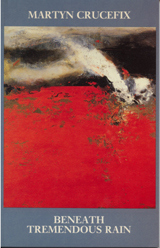One of the joys of social media (and there are plenty of aspects of them that are less than joyful) is that occasionally a notification pops up from an unexpected source and when you check it out there is something really worthwhile to be found. This happened the other day – via Instagram. Someone called Matt McGettrick had tagged me. I don’t know Matt, but he is a student on the BA course in TV and Radio Production at the University of Salford.
Matt’s instapost said he had recently created a soundscape based on a poem I published in 1990, in my first book from Enitharmon Press, called Beneath Tremendous Rain. It’s unlikely that the poem was found in that book itself, but I remember it was selected more than 10 years later by Sean Street to appear in an anthology called Radio Waves: poems celebrating the wireless (Entharmon, 2004). There, I was happily rubbing shoulders with the likes of Auden, Brecht, MacNeice, Heaney and Carol Ann Duffy. Sean – whose is a poet, broadcaster and recently retired Professor of Radio at Bournemouth University – had divided the anthology up into sections variously titled, Music Radio, Talk Radio, Weather, Listeners and Signals. My piece was in the section called ‘In the Car’.
Here’s that original poem. It’s voiced by a persona – I had no children at this point and had not moved out of the ‘dark’ streets of Manchester to the countryside.
Air-Waves
As I slowed up and shifted downgear,
a dance song thumping from the car radio
was stretched out and smashed to pieces.
x
But we barely noticed that first time –
all eager to see the house, where it stood
beneath the surfing crackle of the pylons.
x
The girls loved the sight of so much sky.
They slipped into new schools with ease
though Sue and I made it home more slowly.
x
And by then, there was Stephen, almost four,
suddenly ill, his rush of growing gone awry,
and the doctor’s face, closed up and dark
x
as the Manchester streets we had left behind.
He could tell me nothing. Inexplicable,
the pattern of disease. A year – maybe two.
x
Driving back across the hills, roadside wires
loop down, are yanked back to the blunted head
of each telegraph pole – and further off,
x
the pylons, hitching up skeins of darkness,
striding up country to a house where this car
and their sheaf of hot wires will converge,
x
where a young man’s voice on the radio
will melt down in a surge of boiling static
as I slow up, shift gear, and stop.
I remember a great deal of concern – this will have been in the late 1980s – about the possible harmful effects of living too close to the electrical fields generated by pylons. There was a particular study in 1979 that did conclude there might be a link between electromagnetic fields and childhood cancer (and this is the kind of scenario I am thinking of in the poem). However, other studies in the 2000s did not find an association or found an association only in homes with very high levels of magnetic forces, which is rare, according to the National Cancer Institute.
There was a personal connection, I remember, as my in-laws lived in a house which nestled in beneath a line of high voltage cables and pylons. But perhaps concerns about cancer-inducing lines of pylons have now gone the way of those early concerns about the dangers of mobile phones. Or has it even been consigned to the slightly cranky end of health concerns along with those people who sabotage 5G masts in the name of suspected links to the on-going pandemic? Even so, though it has dated a little, I’d like to think of the poem as one of my earliest expressions of environmental concern: if the electromagnetic fields do turn out to be perfectly safe, they are here acting as a metaphor for the kind of degradation of the lived-in environment caused by human action for which there is an indisputable and growing body of evidence.
Anyway – all this is simply by way of introducing Matt McGettrick’s excellent piece of work. The reader is Matthew Green. As the author of the original piece, it seems to me that both reading and soundscape engineering do a really fine job of responding sensitively to the text’s meaning, its structure and its rhythms. Have a listen – Matt suggests headphones are a good way to hear his work. It’s just over 5 minutes long.


thanks for sending!!
LikeLike
Lynne Wycherley is very preoccupied by this, especially in her book, The Testimony of Trees, 2018, Shoestring.
LikeLike
Thanks Kathleen
LikeLike
Tried to leave comment on site but got lost among passwords. Just to say that Lynne Wycherley in The Testimony of Trees, Shoestring, 2018, is very concerned with this issue. Best wishes Kathleen
>
LikeLike
Sounds like a great way to use the poem in a modern environment and that fact that the university student (Matt) had used this in a different way shows his creativity 😎👍
LikeLiked by 1 person